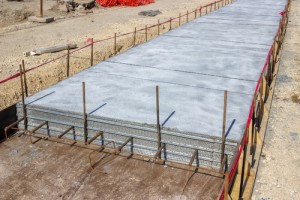To make pouring multiple slabs of concrete more efficient, screed key joints can be used. These relatively simple tools not only allow for multiple slabs or strips of concrete to be poured at once, but they also minimize the risk of cracking within your slabs. If using a screed key joint on your concrete project is necessary, follow these steps to ensure proper and effective use results in high quality slabs.
Install stakes
Before getting to the screed key joints themselves, you’ll need to start with properly installed screed stakes. Start by stretching a line across the entire length of the slab’s location, and install stakes every 20 feet. Additional stakes will also be needed at the ends of the each screed key section. The stakes will need to be driven in until they’re 1/8″ below the intended floor elevation when the slab is finished. In order to drive stakes without flattening the tops, you can use a driving tool. And, to help keep the stake aligned vertically, you can place a 2×4 adjacent to each stake. Once your stakes are installed, attach the line to the tops of each.
Install screed key joints
Once your stakes are in place, the screed key joints can be installed. Typically, you’ll want the key to face the initial concrete placement. Stakes should be placed so each butted joint of the keys are aligned over them. The holes found in the keys are for intermediate stakes to provide additional support. Be sure to install these intermediate stakes once you’ve attached the keys to the initial stakes. You’ll need tin snips or a metal cutting saw to trim up the key joints in certain areas. This will likely need to be done at each instance of joints meeting at 90 degree angles. When installed correctly, you’ll also end up with stakes being installed close to this intersection in each direction. Knockouts are also installed in each screed key joint in order to allow for doweling when necessary. Keys can also be used as a bulkhead for a construction joint by bending the knockout into the pour.
Pouring the slabs
With your stakes and key joints in place, you can begin pouring slabs of concrete. For bigger jobs where the concrete will be placed by truck, you can expedite the process by leaving out sections of key joint temporarily to allow the cement truck to pull through the area. You’ll then quickly add that section when the truck moves on and the cement has been poured. Additionally, even with screed key joints, you’ll likely need to use rebar supports for proper reinforcements.
For any concrete project, large or small, come see us at Maxwell Supply to pick up the proper tools and materials for the job. You can also browse through our inventory online, including an assortment of screed keys, stakes, blades, and more.
